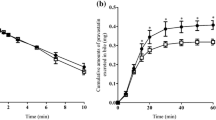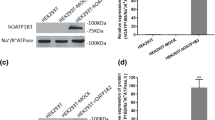Abstract
Background and Objective
Borneol, a traditional Chinese medicine (TCM), is often orally co-administered with other TCM and chemical drugs, but the drug–drug interactions between borneol and the other compounds remains unclear. This work investigates the effect of orally administered borneol on the transcription and expression of hepatic uptake transporters (Ntcp, Oatp2b1, Oatp1a1, Oatp1a4, Oct1, Oct2, Octn2 and Oat2) and efflux transporters (Mdrla, Mrp2, Mrp4 and Mrp5) in rats, aiming to obtain essential information to guide its clinical applications.
Methods
Rats were administered borneol (33, 100 and 300 mg/kg/day, respectively) and vehicle (control) orally via intragastric gavage for 7 consecutive days. The mRNA levels of rat hepatic uptake transporters (Ntcp, Oatp2b1, Oatp1a1, Oatp1a4, Oct1, Oct2, Octn2 and Oat2) and efflux transporters (Mdrla, Mrp2, Mrp4 and Mrp5) were determined using real-time quantitative PCR, while the hepatic Ntcp, Mdrla, Mrp2, Mrp4 and Mrp5 proteins were quantified using western blotting.
Results
The oral administration of borneol led to dose-dependent inhibition of mRNA and protein expression of Mrp4 and Mdr1a, dose-independent inhibition of mRNA and protein expression of Mrp2, and inverse dose-dependent inhibition of mRNA and protein expression of Ntcp. No significant effects were observed for mRNA expression of the other transporters tested following borneol administration.
Conclusions
Oral administration of borneol may affect the metabolism of substances that are involved in bile acid enterohepatic circulation and substrates of Ntcp, Mdrla, Mrp2 and Mrp4 transporters.


Similar content being viewed by others
References
Zhang L, Huang SM, Lesko LJ. Transporter-mediated drug–drug interactions. Clin Pharmacol Ther. 2011;89(4):481–4.
Shimizu M, Fuse K, Okudaira K, Nishigaki R, Maeda K, Kusuhara H, Sugiyama Y. Contribution of OATP (organic anion-transporting polypeptide) family transporters to the hepatic uptake of fexofenadine in humans. Drug Metab Dispos. 2005;33(10):1477–81.
Schinkel AH, Jonker JW. Mammalian drug efflux transporters of the ATP binding cassette (ABC) family: an overview. Adv Drug Deliv Rev. 2003;55(1):3–29.
International Transporter Consortium, Giacomini KM, Huang SM, Tweedie DJ, Benet LZ, Brouwer KL, Chu X, Dahlin A, Evers R, Fischer V, Hillgren KM, Hoffmaster KA, Ishikawa T, Keppler D, Kim RB, Lee CA, Niemi M, Polli JW, Sugiyama Y, Swaan PW, Ware JA, Wright SH, Yee SW, Zamek-Gliszczynski MJ, Zhang L. Membrane transporters in drug development. Nat Rev Drug Discov. 2010;9(3):215–36.
Mandery K, Bujok K, Schmidt I, Keiser M, Siegmund W, Balk B, König J, Fromm MF, Glaeser H. Influence of the flavonoids apigenin, kaempferol, and quercetin on the function of organic anion transporting polypeptides 1A2 and 2B1. Biochem Pharmacol. 2010;80(11):1746–53.
Zolk O, Fromm MF. Transporter-mediated drug uptake and efflux: important determinants of adverse drug reactions. Clin Pharmacol Ther. 2011;89(6):798–805.
Chu Y, Zhang L, Wang XY, Guo JH, Guo ZX, Ma XH. The effect of Compound Danshen Dripping Pills, a Chinese herb medicine, on the pharmacokinetics and pharmacodynamics of warfarin in rats. J Ethnopharmacol. 2013;137(3):1457–61.
Guo QX, Zhang J, Li YQ, Zhang GF. Study on anti-atherosclerotic effect of Suxiao Jiuxin Pill and its mechanism. Afr J Tradit Complement Altern Med. 2013;11(1):97–102.
Fu WJ, Lei T, Yin Z, Pan JH, Chai YS, Xu XY, Yan YX, Wang ZH, Ke J, Wu G, Xu RH, Paranjpe M, Qu L, Nie H. Anti-atherosclerosis and cardio-protective effects of the Angong Niuhuang Pill on a high fat and vitamin D3 induced rodent model of atherosclerosis. J Ethnopharmacol. 2017;195:118–26.
Wei J, Yao L, Yang L, Zhao W, Shi S, Cai Q, Chen D, Li W, Wang Q. Alteration of glutamate/GABA balance during acute alcohol intoxication in rats: effect of Xingnaojing injection. J Ethnopharmacol. 2015;166:333–9.
He H, Shen Q, Li J. Effects of borneol on the intestinal transport and absorption of two P-glycoprotein substrates in rats. Arch Pharm Res. 2011;34(7):1161–70.
Wang SX, Tan N, Ma CC, Wang J, Jia P, Liu JH, Yang Y, Xie ZX, Zhao K, Zheng XH. Inhibitory effects of benzaldehyde, vanillin, muscone and borneol on P-glycoprotein in Caco-2 cells and everted gut sac. Pharmacology. 2018;101(5–6):269–77.
Li Z, Sun D, Yang H, Liu X, Luan L, Bai J, Cui H. Effect of borneol on the distribution of danshensu to the eye in rabbit via oral administration. Curr Eye Res. 2010;35(7):565–72.
Qi HP, Gao XC, Zhang LQ, Wei SQ, Bi S, Yang ZC, Cui H. In vitro evaluation of enhancing effect of borneol on transcorneal permeation of compounds with different hydrophilicities and molecular sizes. Eur J Pharmacol. 2013;705(1–3):20–5.
Jin D, Wang F, Qu L, Li Z, Jin L, Liu P, Xu X, Cui H. The distribution and expression of claudin-5 and occluding at the rat blood-optic nerve barrier after borneol treatment. Mol Biol Rep. 2011;38(2):913–20.
Yu B, Ruan M, Dong X, Yu Y, Cheng H. The mechanism of the opening of the blood–brain barrier by borneol: a pharmacodynamics and pharmacokinetics combination study. J Ethnopharmacol. 2013;150(3):1096–108.
Gao C, Li X, Li Y, Wang L, Xue M. Pharmacokinetic interaction between puerarin and edaravone, and effect of borneol on the brain distribution kinetics of puerarin in rats. J Pharm Pharmacol. 2010;62(3):360–7.
Cai Z, Hou S, Li Y, Zhao B, Yang Z, Xu S, Pu J. Effect of borneol on the distribution of gastrodin to the brain in mice via oral administration. J Drug Target. 2008;16(2):178–84.
Dai JP, Chen J, Bei YF. Influence of borneol on primary mice oral fibroblasts: a penetration enhancer may be used in oral submucous fibrosis. J Oral Pathol Med. 2009;38(3):276–81.
Lai XJ, Zhang L, Li JS, Liu HQ, Liu XH, Di LQ, Cai BC, Chen LH. Comparative pharmacokinetic and bioavailability studies of three salvianolic acids after the administration of Salviaemiltiorrhizae alone or with synthetical borneol in rats. Fitoterapia. 2011;82(6):883–8.
Fan X, Chai LJ, Zhang H, Wang YF, Zhang BL, Gao XM. Borneol depresses P-glycoprotein function by a NF-κB signaling mediated mechanism in a blood brain barrier in vitro model. Int J Mol Sci. 2015;16(11):27576–88.
Wu T, Zhang AQ, Lu HY, Cheng QY. The role and mechanism of borneol to open the blood–brain barrier. Integr Cancer Ther. 2018;1534735418767553.
Zhang R, Mi SQ, Wang NS. Effect of borneol on cytochrome P450 3A enzyme and midazolam pharmacokinetics in rats. Eur J Drug Metab Pharmacokinet. 2013;38(3):159–69.
Chen JY, Wang JJ, Meng MR, Chen Y. Borneol is an inducer of rat hepatic CYP2D activity in vivo. Acta Pharm Sin. 2015;50(4):459–63.
Chen JY, Huang XT, Wang JJ, Chen Y. In vivo effect of borneol on rat hepatic CYP2B expression and activity. Chem Biol Interact. 2017;261:96–102.
National Pharmacopoeia Committee of China. Pharmacopoeia of People’s Republic of China, Part 1. Beijing: Chemical Industry Press; 2015. p. 88.
Bhatia SP, McGinty D, Letizia CS, Api AM. Fragrance material review on L-borneol. Food Chem Toxicol. 2008;46:S81–4.
Le VM, Lecureur V, Stieger B, Fardel O. Regulation of drug transporter expression in human hepatocytes exposed to the proinflammatory cytokines tumor necrosis factor-alpha or interleukin-6. Drug Metab Dispos. 2009;37(3):685–93.
Alrefai WA, Gill RK. Bile acid transporters: structure, function, regulation and pathophysiological implications. Pharm Res. 2007;24(10):1803–23.
Stieger B. The role of the sodium-taurocholate co-transporting polypeptide (NTCP) and of the bile salt export pump (BSEP) in physiology and pathophysiology of bile formation. Drug transporters. Berlin: Springer; 2011. p. 205–59.
Ho RH, Tirona RG, Leake BF, Glaeser H, Lee W, Lemke CJ, Wang Y, Kim RB. Drug and bile acid transporters in rosuvastatin hepatic uptake: function, expression, and pharmacogenetics. Gastroenterology. 2006;130(6):1793–806.
Dawson PA, Lan T, Rao A. Bile acid transporters. J Lipid Res. 2009;50(12):2340–57.
Choi MK, Shin HJ, Choi YL, Deng JW, Shin JG, Song IS. Differential effect of genetic variants of Na+-taurocholate cotransporting polypeptide (NTCP) and organic anion-transporting polypeptide 1B1 (OATP1B1) on the uptake of HMG-CoA reductase inhibitors. Xenobiotica. 2011;41(1):24–34.
Gartung C, Matern S. Molecular regulation of sinusoidal liver bile acid transporters during cholestasis. Yale J Biol Med. 1997;70(4):355–63.
Choudhuri S, Klaassen CD. Structure, function, expression, genomic organization, and single nucleotide polymorphisms of human ABCB1 (MDR1), ABCC (MRP), and ABCG2 (BCRP) efflux transporters. Int J Toxicol. 2006;25(4):231–59.
Zhang QL, Fu BM, Zhang ZJ. Borneol, a novel agent that improves central nervous system drug delivery by enhancing blood–brain barrier permeability. Drug Deliv. 2017;24(1):1037–44.
Zhou SF. Structure, function and regulation of P-glycoprotein and its clinical relevance in drug disposition. Xenobiotica. 2008;38(7–8):802–32.
Miller DS, Bauer B, Hartz AM. Modulation of P-glycoprotein at the blood–brain barrier: opportunities to improve central nervous system pharmacotherapy. Pharmacol Rev. 2008;60(2):196–209.
Maki H, Hiroyuki K, Masashi A, John DS, Kenji T, Yuichi S. Multidrug resistance-associated protein 4 is involved in the urinary excretion of hydrochlorothiazide and furosemide. J Am Soc Nephrol. 2007;18(1):37–45.
Lei C, Hiroyuki K, Masashi A, John DS, Kenji T, Yuichi S. Involvement of MRP4 (ABCC4) in the luminal efflux of ceftizoxime and cefazolin in the kidney. Mol Pharmacol. 2007;71(6):1591–7.
Gabriele J, Brian B, Dietrich K. The multidrug resistance protein 5 functions as an ATP-dependent export pump for cyclic nucleotides. J Biol Chem. 2000;275(39):30069–74.
Peter RW, Ingrid DDH, Glen R, Jos HB, Jan W, Piet B. Characterization of the MRP4- and MRP5-mediated transport of cyclic nucleotides from intact cells. J Biol Chem. 2003;278(20):17664–71.
Author information
Authors and Affiliations
Corresponding author
Ethics declarations
Funding
No funding was received to conduct this study.
Conflict of interest
Lin Chen, Lu Liao, Ting Zhai, Xiangtao Huang and Yong Chen declare that they have no conflict of interest.
Ethical approval
This study was approved by the Ethic Committee of Hubei University and complied with health guidelines for the care and use of laboratory animals.
Electronic supplementary material
Below is the link to the electronic supplementary material.
Rights and permissions
About this article
Cite this article
Chen, L., Liao, L., Zhai, T. et al. Influence of Orally Administered Borneol on the Expression of Hepatic Transporters in Rats. Eur J Drug Metab Pharmacokinet 44, 103–109 (2019). https://doi.org/10.1007/s13318-018-0499-1
Published:
Issue Date:
DOI: https://doi.org/10.1007/s13318-018-0499-1




